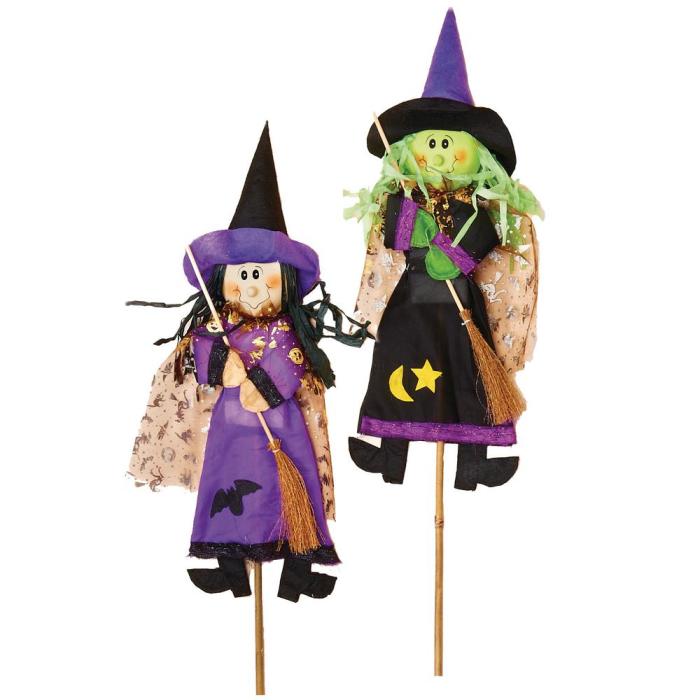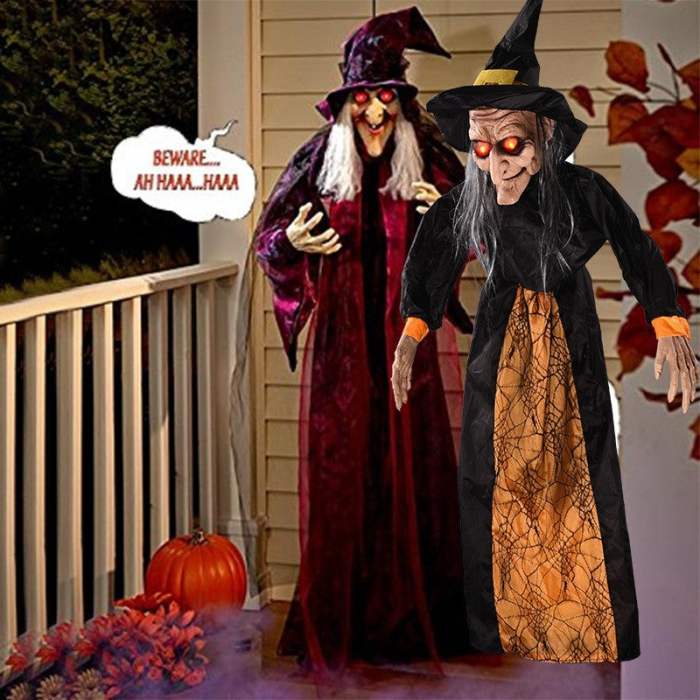Witch Decor transcends mere aesthetics; it’s a captivating blend of symbolism, history, and personal expression. This immersive exploration delves into the enchanting world of witchy home design, uncovering the core elements that define its unique style. From the subtle charm of cottagecore witch aesthetics to the darker allure of dark academia, we’ll examine diverse sub-styles, tracing their evolution and uncovering the rich symbolism embedded within each carefully chosen item.
We’ll journey through popular decor items, analyzing their symbolic meanings and practical applications. Discover the power of color palettes, material choices, and textures in shaping the overall ambiance. Learn how to seamlessly integrate witch decor into various living spaces, from cozy living rooms to functional workspaces, ensuring a harmonious blend of style and practicality. Finally, we’ll delve into the historical and cultural context of these symbols, unveiling the stories woven into the fabric of witch decor.
Defining “Witch Decor” Aesthetics

Witch decor, a burgeoning interior design trend, transcends mere aesthetics; it’s a powerful expression of individuality, spirituality, and a connection to nature and the mystical. It blends elements of various styles, creating a unique and often eclectic atmosphere that reflects the wearer’s personal interpretation of witchcraft and its associated symbolism. This style isn’t about literal representations of witches, but rather the evocation of a feeling, a mood, a sense of enchantment.Witch decor’s core visual elements revolve around a harmonious blend of natural materials, mystical symbolism, and a touch of the darkly romantic.
Think deep jewel tones, rich textures, and an overall atmosphere that feels both cozy and mysterious. Common visual elements include candles (often in abundance), crystals, dried herbs and flowers, antique or vintage finds, tarot cards, and books on esoteric subjects. The overall effect aims for a space that feels both inviting and imbued with a sense of magic.
Sub-styles within Witch Decor
Different sub-styles within witch decor cater to diverse aesthetics and interpretations of witchcraft. These sub-styles borrow elements from broader design trends, infusing them with witchy flair. For example, cottagecore witch decor emphasizes rustic charm, featuring floral patterns, wicker furniture, and a focus on natural light. Dark academia witch decor, conversely, leans towards a more scholarly and sophisticated aesthetic, incorporating rich wood tones, leather-bound books, and a muted color palette.
Bohemian witch decor embraces a free-spirited and eclectic approach, incorporating global textiles, macrame, and a layering of textures and patterns. Each sub-style offers a unique lens through which to explore the broader theme of witch decor.
Evolution of Witch Decor Trends
The evolution of witch decor reflects broader societal shifts and changing perceptions of witchcraft. Initially, witch decor was largely associated with a more overtly gothic aesthetic, heavily influenced by Halloween imagery. However, as witchcraft has gained wider acceptance and understanding, the aesthetic has diversified. The rise of social media platforms like Instagram and Pinterest has played a significant role, allowing for the sharing and dissemination of diverse interpretations of witch decor.
This has led to a more inclusive and personalized approach, with individuals blending different styles to create spaces that authentically reflect their own unique practices and beliefs. Modern witch decor shows a growing emphasis on sustainability, incorporating repurposed and vintage items, reflecting a broader environmental consciousness.
Mood Board: Evocative Descriptions of Witch Decor
Imagine a dimly lit room, the air thick with the scent of woodsmoke and dried herbs. Warm candlelight flickers across aged wooden shelves laden with apothecary jars filled with mysterious powders and crystals that catch the light like captured starlight. Rich velvet curtains frame a window overlooking a moonlit garden, while the floor is strewn with intricately woven rugs in deep jewel tones.
A comfortable armchair, draped with a tapestry depicting celestial imagery, invites relaxation. Books with gilded spines line the walls, hinting at untold secrets and ancient wisdom. The overall feeling is one of cozy mystery, a space both inviting and imbued with a sense of quiet power and ancient magic. The colors are deep and earthy – deep greens, rich browns, and shadowy purples, punctuated by the warm glow of candlelight and the sparkle of crystals.
The textures are varied and luxurious – the smoothness of polished wood, the softness of velvet, the roughness of hand-woven textiles.
The Symbolism and Meaning Behind Witch Decor Elements

Witch decor is more than just aesthetically pleasing; it’s a carefully curated collection of symbolic objects imbued with meaning and intention. Each element, from crystals to candles to animal representations, contributes to the overall atmosphere and narrative of a space, reflecting the practitioner’s beliefs and practices. Understanding the symbolism behind these elements provides a deeper appreciation for the craft and intentionality behind this unique style of interior design.
Crystals, Candles, and Herbs: A Triad of Symbolic Power
Crystals, candles, and herbs are foundational elements in many witch decor aesthetics. Crystals, chosen for their purported metaphysical properties, represent energy, intention, and connection to the earth. Amethyst, for instance, is often associated with spiritual awareness and tranquility, while citrine is linked to abundance and prosperity. The placement and arrangement of these crystals within a space can subtly influence the energy flow and atmosphere.
Candles, representing the element of fire, symbolize transformation, purification, and illumination. Their color and type further enhance their symbolic meaning; a white candle might represent purity, while a black candle could signify banishing negativity. Herbs, with their rich history in herbalism and magic, add another layer of symbolism. Lavender, known for its calming properties, might be used to promote relaxation, while rosemary, associated with remembrance and memory, could be included in a space dedicated to ancestral work.
The combination of these three elements creates a complex and layered tapestry of meaning within a witch’s space.
Animal Representations in Witch Decor
The inclusion of animals in witch decor is significant, reflecting the deep connection many practitioners have with the animal kingdom and their associated symbolism. Cats, often depicted in art or figurines, represent independence, mystery, and intuition, aligning with the independent and often secretive nature associated with witchcraft. Owls, with their association with wisdom and insight, might symbolize deeper understanding and spiritual guidance.
Snakes, frequently misunderstood, symbolize transformation, healing, and shedding of the old self. Conversely, animals like deer, representing gentleness and grace, might be included to bring a sense of serenity and connection to nature. The specific animal chosen and its representation, whether through statues, artwork, or textiles, contributes to the overall ambiance and narrative of the space, reflecting the practitioner’s personal connection with the animal and its symbolic meaning within their practice.
Historical and Cultural Context of Witch Decor Symbols
Many of the symbols commonly found in witch decor have deep historical and cultural roots within witchcraft and pagan traditions. The use of crystals, for example, can be traced back to ancient civilizations who valued their healing and spiritual properties. Similarly, the use of candles in rituals and ceremonies has a long history across various cultures and religions, signifying illumination, guidance, and spiritual connection.
Herbalism, a cornerstone of many traditional healing practices, plays a crucial role in witch decor, reflecting the continued importance of natural remedies and their connection to the earth. The incorporation of these symbols within modern witch decor serves as a continuation of these ancient traditions, preserving and celebrating their cultural significance while adapting them to contemporary contexts. The careful selection and placement of these elements demonstrate a conscious effort to create a space that is not merely decorative but also deeply meaningful and symbolically rich.
Ultimately, Witch Decor offers a pathway to creating a space that reflects your unique personality and spiritual journey. By understanding the symbolism, history, and practical applications of its diverse elements, you can craft a home environment that is both aesthetically pleasing and deeply meaningful. Embrace the magic, personalize your style, and let your home become a sanctuary reflecting your inner witch.